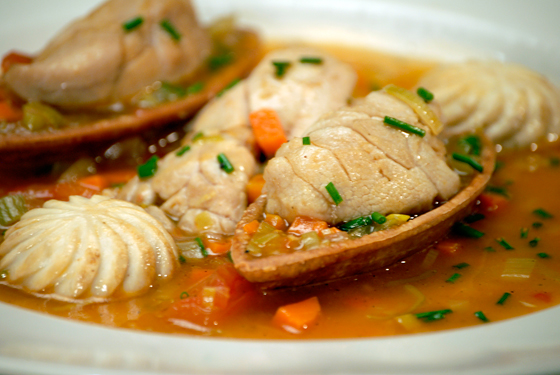Braised Sweetbreads in Mirepoix
Episode 107: Economical Offal
Recipe: Braised Sweetbreads in Mirepoix
In this recipe, the sweetbreads are separated into pieces, braised in a vegetable sauce, and served in cream cheese barquettes.
Serves 6
Barquettes
4 ounces cream cheese
3 tablespoons unsalted butter, softened
1 cup all-purpose flour
Sweetbreads
2 1/2 pounds sweetbreads, blanched and pressed
3 tablespoons unsalted butter
2 celery stalks, cut into 1/8-inch dice (about 1 cup)
1 leek, trimmed (leaving some green); split; washed; and cut into 1/8-inch pieces (about 1 cup)
1 large carrot, peeled and cut into 1/8-inch dice (about 1 cup)
1 medium onion, cut into 1/8-inch dice (about 1 cup)
1 large or 2 medium tomatoes (10 ounces); peeled; halved; seeded; and chopped
1 teaspoon chopped garlic
1 cup Brown Sauce (see recipe below)
1/2 cup dry white wine
1/2 teaspoon salt
1/2 teaspoon freshly ground black pepper
4 or 5 fresh thyme sprigs
1 teaspoon potato starch, dissolved in 1 tablespoon water
FOR THE BARQUETTES: Combine the cream cheese and butter in a food processor and process about 5 seconds to mix well. Add the flour and process just long enough for the dough to hold together. Wrap the dough in plastic and allow it to rest in the refrigerator for a few hours to firm up.
Sprinkle the work surface with flour and roll out the dough, pressing on it lightly with your rolling pin. Keep rolling, extending the dough from the center outward in all directions, rather than just rolling back and forth, which tends to develop the gluten and toughen the dough. The dough should be about ¼ inch thick.
Roll it up onto the rolling pin and brush any flour off the dough. Arrange little barquette molds (about 4 inches long by 2 inches wide) side by side on the work surface, unroll it on top of the barquettes. Press the dough into the molds, then roll the rolling pin on top of the molds to trim off the extra dough. If the barquettes are not completely separated, press the dough on the edges of the barquettes to cut it off.
To prevent the dough from shrinking, falling on itself, or getting too many bubbles while cooking, press another mold on top of the dough in each barquette to thin it further and make it adhere well to the mold. In this way, the dough will conform to the inside of the bottom molds and keep its shape during cooking. (Leave these barquettes in place.) Let the barquettes rest for 1 hour to help prevent shrinking.
Preheat the over to 400 degrees.
Arrange the molds on a cookie sheet and bake for 15 to 20 minutes; by then the dough will have set. Remove the top molds and bake for another 10 to 15 minutes, to brown nicely. Remove the barquettes from their molds.
FOR THE SWEETBREADS: Break the sweetbreads into 1-inch lumps, separating them from the connecting tissue.
Melt the butter in a large saucepan. When it is hot, add the celery, leeks, carrots, and onions and cook over medium-high heat for about 5 minutes, stirring occasionally, until the vegetables are wilted and soft. Add the tomatoes, garlic, brown sauce, wine, salt, pepper, thyme sprigs, and sweetbreads, and bring to a boil, then cover, reduce the heat, and simmer for 10 to 12 minutes.
Add the dissolved potato starch to the sweetbread mixture to thicken it slightly, then add the fluted mushrooms and warm for about 30 seconds in the sauce. Arrange a barquette in the middle of each plate. Fill with sweetbreads, and spoon more of the mixture around the plate. Serve.
BASIC BROWN SAUCE
Makes about 2 quarts
A basic and essential ingredient for the cook, brown sauce is added to other sauces or used to create a sauce for meat or poultry. Mine is slightly thickened with flour, which loses its raw taste through the long cooking process. The sauce can be made with all chicken bones or with turkey bones.
4 pounds veal or beef bones (shins, necks, tails, etc.), cut into 3-inch pieces (you can have the butcher do this)
1 pound chicken bones (necks, wings, backs, etc.)
2 cups diced onions
1 cup diced carrots
1 cup diced celery
6 garlic cloves, crushed but not peeled
1/3 cup all-purpose flour, dissolved in 1½ cups water
1/4 cup tomato paste
8 quarts cold water
1 cup dry white wine
2 tablespoons dark soy sauce
1 teaspoon black peppercorns
3 bay leaves
1 teaspoon crushed dried thyme
Put the bones in a large stockpot and cook over high heat, stirring occasionally, for 15 minutes. Reduce the heat to medium and cook for another 15 minutes, until they are browned and have rendered some fat. (There should be enough fat on the bones and in the skin to brown the bones.)
Add the onions, carrots, celery, and garlic and cook for another 15 minutes or so, stirring, until the bones and vegetables are lightly browned.
Drain the bones and vegetables in a colander to eliminate the fat and return them to the pot.
Add the flour mixture, tomato paste, water, wine, soy sauce, peppercorns, bay leaves, and thyme to the pot and bring to a boil, then reduce the heat and simmer slowly, uncovered, for about 3 hours, until reduced to about 8 cups. Skim off and discard the foam that comes to the top after 30 minutes. Strain the sauce through a fine strainer.
The sauce can be kept covered in the refrigerator for up to 1 week, or it can be divided among small plastic containers and frozen.
ALTERNATE METHOD: Heat the oven to 400 degrees. Arrange the bones in one layer in a large roasting pan or on a baking sheet and roast for 1 hour, stirring the bones to brown on all sides. Sprinkle the onions, carrots, celery, and garlic on top and roast for another 30 minutes.
Drain the bones and vegetables in a colander and discard the fat. Add the bones to a stockpot. Deglaze the roasting pan or cookie sheet with 2 to 3 cups water and heat to melt the solidified glaze. Add to the stockpot.
Continue with the recipe, adding the flour, tomato paste, the water, and the other ingredients.
Copyright © 2011 by Jacques Pépin. Used by permission of Houghton Mifflin Harcourt. All rights reserved.











